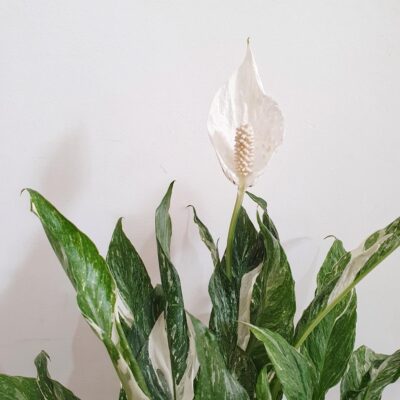Peace Lily
Peace lily (Spathiphyllum cochlearispathum) is a plant species that is native to southern Mexico. Peace lily is commonly cultivated as an ornamental houseplant. This species should not be grown in direct sunlight. Spathiphyllum spp. are popular indoor, ornamental plants with white spathes. They are easy to care for and can grow well with little sunlight. […]
About

Shop now
Description
Tips from Garden Coaches
Care Guide
People often ask
Spathiphyllum spp. are popular indoor, ornamental plants with white spathes. They are easy to care for and can grow well with little sunlight.
Originally grown in tropical rain forests, peace lily are understory plants and can adapt to environments with little light intensity. However, it is difficult to blossom under low light conditions, so peace lily need a sufficient amount of filtered light. For example, you can place peace lily indoors near a window while avoiding direct sunlight. Yellowing of the leaves indicates that the light intensity may be too strong, and browning or streaking of leaves indicates that direct sunlight has burned the plant. In this case, consider placing the flowerpot about 1.8-2 m away from the window.
Peace lily make excellent houseplants for the home or office.
North or West facing windows are best.
Peace lily live on average from three to five years.
Peace lily will appear wilted with brown edges on the leaves; roots will look puny, feel mushy, and turned dark brown or black.
Coax your peace lily to bloom by making sure it gets the proper amounts of water and light.
If your peace lily is dropping even after watering, you are likely overwatering and the plant is suffering. These plants like consistently moist soil but hate being soggy or waterlogged.
Yellowing or withering leaves may be caused by strong sunlight, alkaline soil, excessive fertilizer, too little or too much water, long periods of drought or too-wet soil, poor drainage, permeability, and low-temperature injuries caused by open doors and windows or air conditioning and fans. For indoor care, the plant should be placed in a location with sufficient sunlight, but should not be exposed to direct sunlight. For weak, alkaline soil, acidity and alkalinity can be adjusted with rainwater. Cut off any seriously dry branches and leaves. If the soil is very dry, water it promptly and increase the air humidity. If there is sufficient water in the soil, no immediate watering is necessary. Appropriate sunlight and fertilizer should be offered according to the Care Guide. Low-temperature environments should be avoided, and plants should be kept away from air conditioning, fans, and similar appliances.
Lack of blooming is caused by insufficient sunlight, water, or fertilizer, too-low temperatures, or extended use of tap water with high mineral salts. To combat this issue, increase sunlight and moisture, maintain the temperature at 18-24 ℃, supplement fertilizer with high phosphorus and potassium contents (or purchase fertilizer specially designed for promoting flowering) and use rainwater or distilled water instead of tap water for watering.
The problem may be insufficient sunlight or fertilizer deficiency. Provide sufficient filtered light as needed, avoid overly dry or wet soil, and appropriately add fertilizer with a high phosphorus content to promote blooming.
Reduce water supply, repot or transplant the plant, and cut off rotten roots. Replace the soil with well-draining and permeable culture medium, and use suitable materials based on the recommendations in the Care Guide. Avoid overly wet soil and water accumulation, ensure smooth drainage at the bottom of the flowerpot, and avoid water accumulation in the tray. Pesticides may also be necessary according to plant symptoms, as detailed under the “Pests and Diseases” section.











